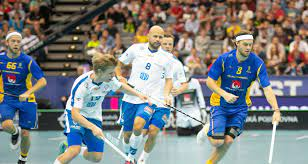Story of the swedish flooball wonder
From American plastic hockey via swedish gyms around the country and then out
in the world. Floorball has had detours and bumps in the road but dispite that it has in a short time grown into one of Sweden's largest sports and been exported to all continents in the world.
Floorball has many interesting features and is a fast-pace game. Few sports have ever expanded so rapidly in Sweden and it's not usually famous for being a exporter of new sports. It's basically the swedish floorball wonder.

Early days of floorball in Sweden could look something like this
Is floorball even a swedish sport?
In the USA in the 1960s, floorhockey was launched, which was played with straight plastic clubs and plastic pucks. Plastic manufacturers wanted to experiment and create new markets and started producing hollow ball, which is typical nowadays for floorball, and the banana-shaped stick.

Every swedish kid in school have played with sticks that looks like this on the breaks out on the school yard
According to an often shared story about it's background, one should group of swedish students went on a holiday trip to Holland in 1968 and saw the curved plastic clubs in a shop window. Intrigued by them, they had buy some to take with them home and then they started playing. This trend then started to spread around the country. It didn't take long before swedish manufacturers started to produce their own sticks and balls to sell.
Floorhockey variants with the straight clubs never got any popularity in Sweden, but I think it looks really cool if you look at this image from a game in the US.

In 1979, the country's first floorball club was started: Sala IBK. Another early
floorball center was the small town of Fagersta where, among other things, in 1981 they arranged the first regular league with 22 men's and 16 women's teams.
When The Swedish National Cup was played for the first time in 1982-83, teams from Fagersta won both the women and men category. Another important one pioneer town was Mariestad. These places were all fairly small. A argument put forward is that floorball could gain a foothold early on these places, because that was missing
competition from other major winter sports such as icehockey, handball and bandy.

In 1981, the Swedish Floorball Association was formed and they got accepted at the first attempt into Swedish Sports Confederation (RF) in 1985.
After the entry of RF, the number of members increased quickly and after Sweden both arranged sand won the first World Cup In 1996, the curve continued to point upwards. The World Cup final 1996 had 15 106 spectators in the Globen arena and this really got the trend to grow even more.
In the 2020s we have over 120k registered players in Sweden, both man and women, and almost 1000 clubs. Sweden is also so far the most successful nation in the world cup with 8 gold and 4 silvers, but in the last world cups they have been defeated by their biggest rival Finland!

Wow, first of all. Thank you for pointing me to such a great sport. I didn't think this really existed before. I saw it once on a Malcolm in the Middle episode and didn't think it was a real thing with crowds and all that. It looks like it would be extremely fun to watch. I will definitely add floorball to my list of consumption.
If you have to chance to watch a game you should! Fast-pace, lots of goals usually and some player with amazing stick handling! Perfect match in my opinion ;)